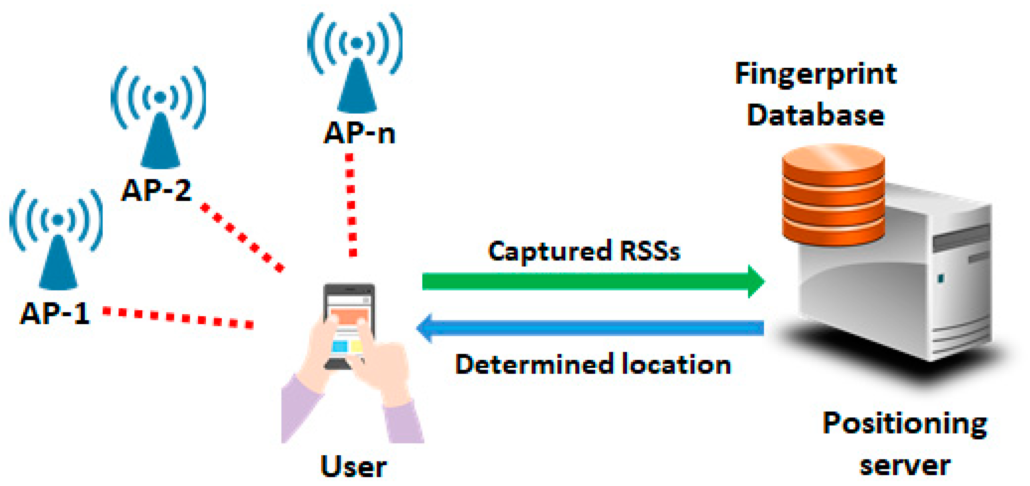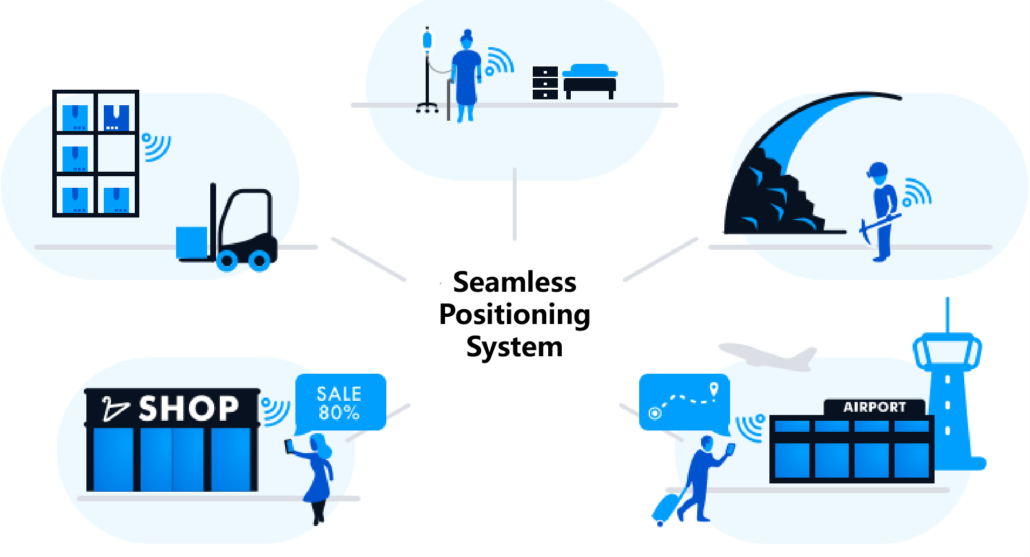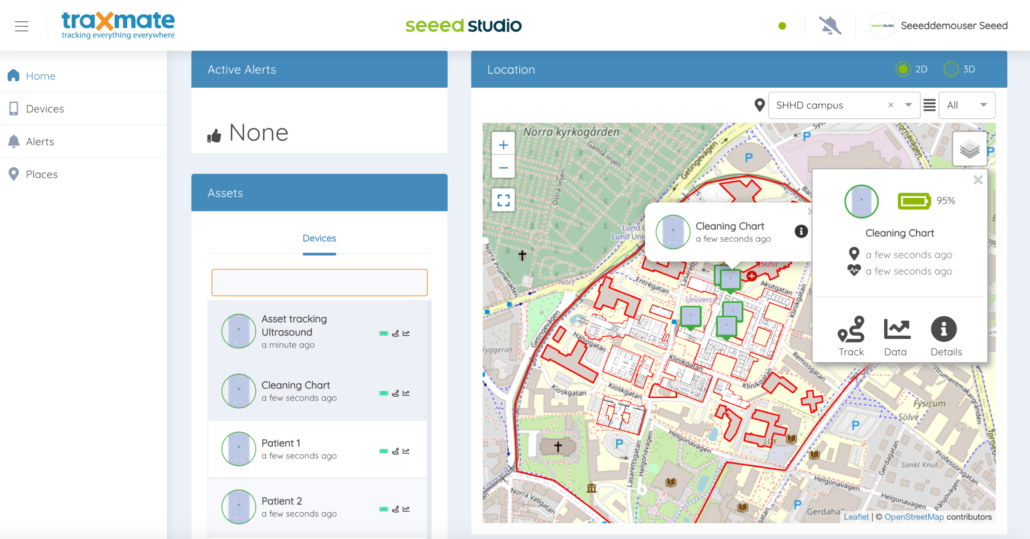3 Core GPS Tracking Technologies of GNSS, Wi-Fi, and BLE: How They Work, The Differences, and Applications with a Live Demo
Introduction
In today’s interconnected world, tracking technologies have become indispensable in various industries, enabling businesses to monitor and manage their assets with precision and efficiency. From logistics and transportation to healthcare and retail, the ability to track and locate objects in real-time has revolutionized operations and opened up new possibilities. In this article, we delve into three core tracking technologies that are shaping the landscape of asset management: GNSS, Wi-Fi, and Bluetooth. We will explore how these technologies work, highlight their differences, and shed light on their diverse applications across different sectors, with a joint live demo of asset and personnel tracking in hospital. Join us as we unravel the fascinating world of tracking and discover how these technologies are transforming industries worldwide.
Three Commonly Used Positioning Technologies
Advancements in positioning technologies have brought about remarkable improvements in accuracy, versatility, and convenience. Among the most widely adopted positioning technologies are Global Navigation Satellite Systems (GNSS), Wi-Fi positioning, and Bluetooth-based positioning. These technologies are revolutionizing our perception and interaction with the world, both indoors and outdoors.
When it comes to outdoor positioning, GNSS technology reigns supreme as the preferred solution. By leveraging satellite signals, GPS can accurately determine the geographic location of devices. On the other hand, indoor positioning technologies rely on different principles to pinpoint device locations within buildings or enclosed spaces. Wi-Fi positioning and Bluetooth positioning have emerged as the most prevalent methods for indoor positioning.

How They Work?
GNSS: GNSS (Global Navigation Satellite System) is the generic term for any of the satellite constellations that broadcast positioning, navigation and timing data. Currently, four global systems are operational: the United States’s Global Positioning System (GPS), Russia’s Global Navigation Satellite System (GLONASS), China’s BeiDou Navigation Satellite System, and the European Union’s Galileo. The satellites provide signals from space that transmit positioning and timing data to GNSS receivers. The receivers then use this data to determine location. By comparing the time difference between when a satellite starts transmitting and when the signal is received at the receiver, we can calculate the distance between the satellite and the receiver. When we have the distances between the receiver and at least three satellites, we can use trilateration to determine the receiver’s position.
Wi-Fi: Wi-Fi positioning utilizes the Received Signal Strength Indicator (RSSI) of Wi-Fi signals and distance information between multiple Wi-Fi access points (APs) to determine the device’s location. Each AP has a globally unique MAC address. WiFi positioning relies on detecting the MAC addresses of all nearby wireless APs and comparing them to a database that contains the coordinates associated with those MAC addresses. By cross-referencing the MAC addresses with the database, the location can be calculated.
Bluetooth: Bluetooth positioning is similar to WiFi positioning, relies on Bluetooth signal broadcasting and RSSI measurements to estimate the distance between the device and the receiver. This information is then used to determine the device’s location. By measuring the distances between multiple Bluetooth base stations and applying trilateration.
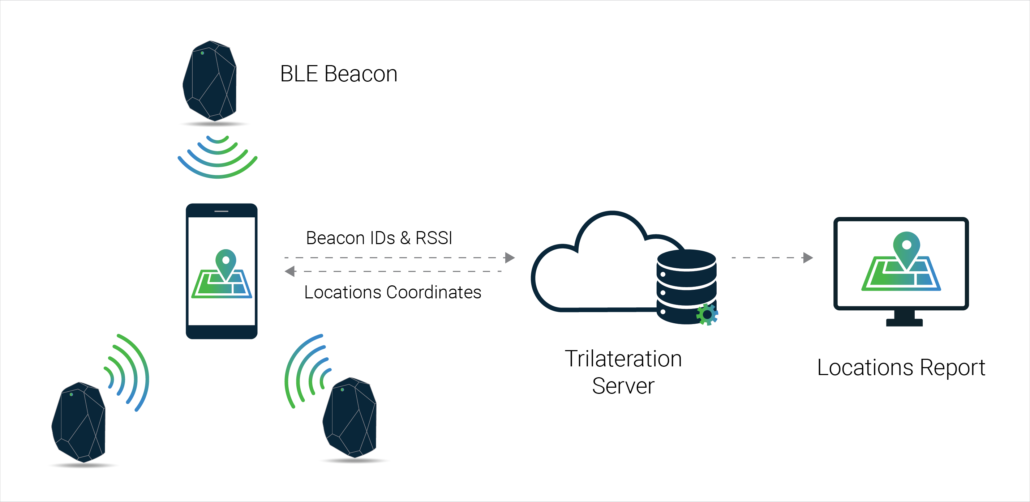
Comparison
GNSS technology, such as GPS, is primarily designed for outdoor positioning applications like vehicle trajectory tracking. However, it tends to perform poorly in indoor environments. The limited penetration capabilities of GPS signals indoors, coupled with obstructions like buildings, can hinder signal reception, resulting in decreased accuracy or even the inability to obtain a GPS fix.
When it comes to indoor positioning, both WiFi and Bluetooth can be utilized. However, there are distinct differences between the two technologies. Bluetooth generally offers higher accuracy, lower power consumption, and requires the deployment of Bluetooth beacons. This makes it well-suited for applications that demand precise location information within a small range, particularly for asset tracking purposes.
On the other hand, Wi-Fi has a larger signal coverage range and leverages existing infrastructure, making it suitable for environments with a broader mobile range and a greater number of access points (APs). Wi-Fi positioning can be advantageous in scenarios where comprehensive coverage is needed for indoor positioning.
Below is the detailed comparison:
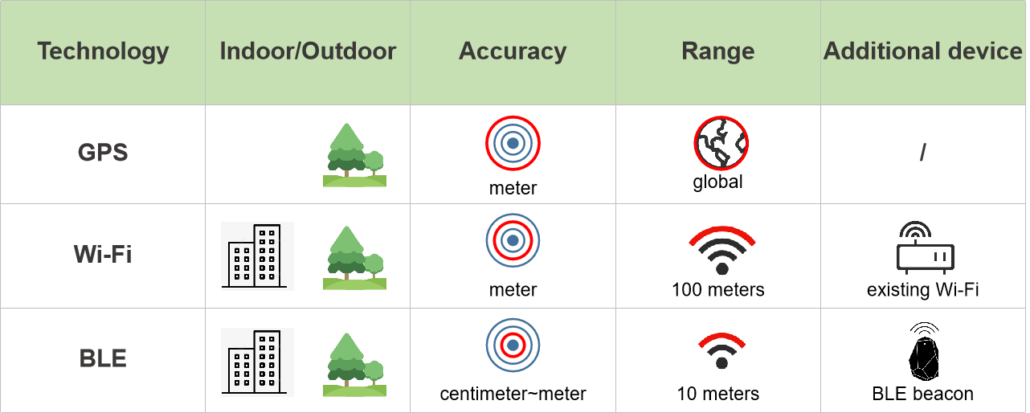
Why We Need Seamless Indoor and Outdoor Tracking?
According to Mordor Intelligence’s research, the asset tracking market size is estimated at USD 20.37 billion in 2023 with an expectation to reach USD 38.05 billion by 2028, registering a CAGR of 13.91% during the forecast period (2023-2028). The need for seamless indoor and outdoor tracking has also become increasingly vital in today’s interconnected world. As our daily lives become more mobile and dynamic, the ability to track assets and individuals seamlessly across different environments has become crucial for various industries as most businesses cover an entire area of buildings, and outdoor sites. Whether it’s optimizing logistics operations, enhancing safety and security measures, or improving the overall customer experience, seamless tracking offers immense benefits. It enables businesses to have a comprehensive view of their assets’ movements, both indoors and outdoors, ensuring efficient resource allocation, effective decision-making, and streamlined operations. By bridging the gap between indoor and outdoor tracking, organizations can unlock new opportunities for innovation, productivity, and improved performance across a wide range of sectors.
Seamless indoor and outdoor tracking also plays a pivotal role in enhancing the overall user experience and enabling personalized services. In retail environments, for example, tracking technologies can provide valuable insights into customer behavior, enabling businesses to offer tailored recommendations, targeted promotions, and optimized store layouts. Similarly, in healthcare settings, seamless tracking ensures the safety and well-being of patients by allowing precise location monitoring and efficient asset management of medical equipment. Moreover, in smart cities and transportation systems, the integration of indoor and outdoor tracking technologies enables smooth navigation, efficient public transportation management, and real-time monitoring of traffic conditions. The seamless fusion of indoor and outdoor tracking that provides reliable indoor, outdoor and underground location data fosters efficient and safe operation.
A Game Changer for Seamless Indoor and Outdoor Tracking: SenseCAP T1000
What’s SenseCAP T1000?
To achieve more accurate positioning and cater to various application needs, it is advantageous to select a tracker that integrates multiple positioning technologies. The SenseCAP T1000 tracker excels in this regard, as it offers high-performance and an array of features. It seamlessly combines GNSS, WiFi, and Bluetooth positioning technologies in a compact, credit card-sized design that can be effortlessly carried in a pocket or attached to assets and vehicles.
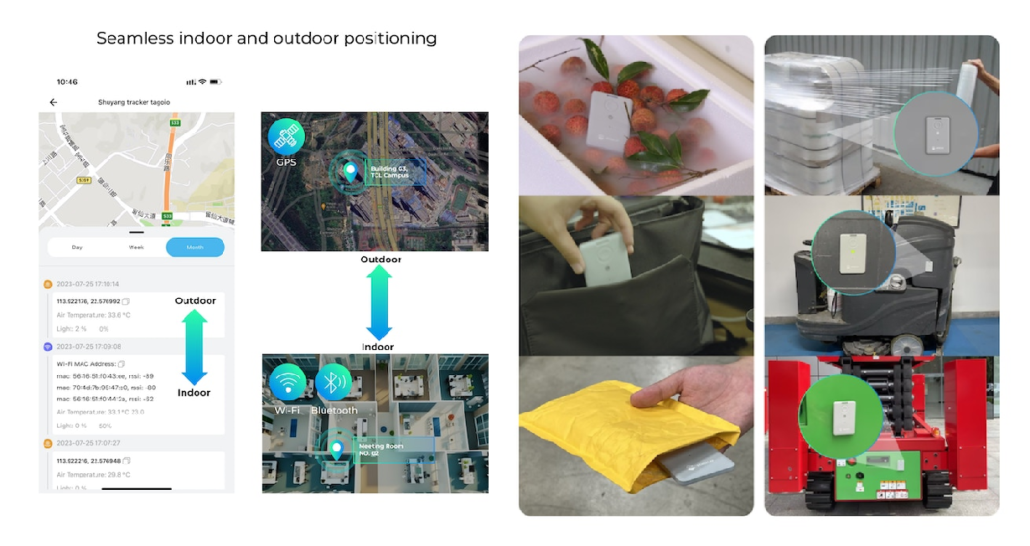
The SenseCAP T1000 tracker goes beyond simply tracking location by offering additional monitoring capabilities. It includes sensors such as a temperature sensor, which is ideal for monitoring temperature-sensitive goods like food, and a light sensor that can detect unpacking activities. This data is valuable for ensuring compliance verification.
Furthermore, the motion sensor in the tracker is useful for identifying when goods are in transit and monitoring potential physical damages. It can report various statuses, including detecting shocks, the start and end of movement, and motionless timeout. Such data can be utilized for insurance claims and optimizing logistics operations.
In case of emergencies, the SenseCAP T1000 tracker is equipped with a panic button. Activating the panic button switches the tracker to SOS mode, prompting it to send data frequently to the designated platform. Additionally, the built-in buzzer alerts people nearby that an emergency situation has occurred.

With its versatility, the SenseCAP T1000 tracker finds applications in logistics and supply chain management, search and rescue operations, and industrial monitoring. It serves as a comprehensive solution for tracking assets, ensuring personnel safety, and monitoring equipment performance in varied scenarios.

Real-World Application: SenseCAP T1000 for Asset and Personnel Tracking in Hospital
According to the data from GE Healthcare, only 38% of hospital inventory is fully utilized. The remaining inventory is often misplaced, stolen, or difficult to locate when needed. To solve this problem, it’s time to apply SenseCAP T1000 Tracker’s Bluetooth+WiFi+GNSS mode to ensure an efficiant asset tracking for the hospital inventory.

In the Lunds University Hospital Area in Sweden, we partnered with Traxmate , an IoT tracking platform for seamless indoor/outdoor tracking with floor & room level accuracy created a joint live demo, showcasing an asset and personnel tracking solution to improve the visibility of high-value medical equipment and enhancing emergency response services.The solution utilises SenseCAP T1000 LoRaWAN Trackers, which have been be easily attached to assets (portable ultrasound and X-ray machines, cleaning charts), or worn by patients.
Combining BLE, Wi-Fi scanning, and GNSS, it offers seamless indoor-to-outdoor location tracking across the hospital. It also collects and transmits environmental data via The Things Network for better maintenance scheduling and, compliance & utilization monitoring. Traxmate‘s tracking platform provides a floor-level accuracy map with direct tracking visualization. It includes geofencing features that alert the hospital management team if assets leave predefined areas, aiding in their recovery. Moreover, the solution incorporates an SOS Button on the tracker to ensure faster response services and enhance patient safety. Click here to view and explore the live demo here.
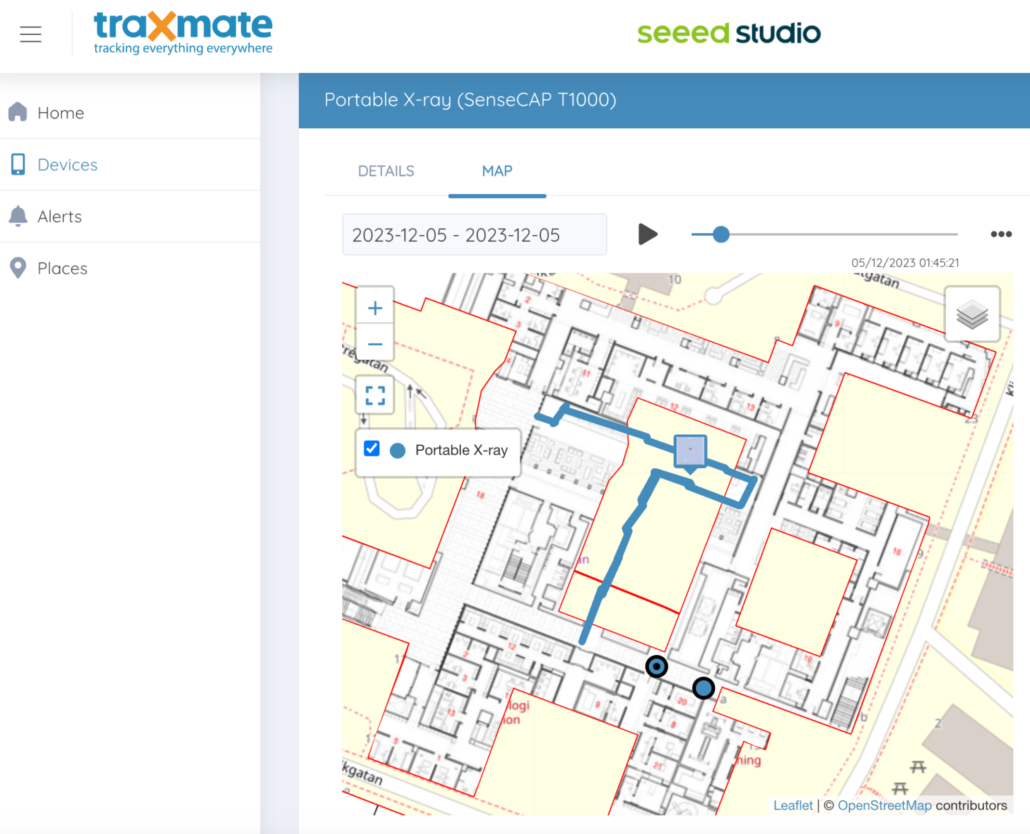
Summary
As the need for a seamless indoor and outdoor tracking is increasing, we’re happy to cover three types of positioning technologies of GNSS, Bluetooth, and Wi-Fi in this article to explore their principles, technical characteristics, and applications. Furthermore, we’ve also highlighted the SenseCAP T1000 tracker, a product that offers seamless indoor-outdoor positioning, and its applications in asset and personnel tracking at Lund University Hospital Area in Sweden. With this joint live demo with Traxmate, we’d love to showcase how a tracking solution can improve the visibility of high-value medical equipment and enhance emergency response services in healthcare facilities, ultimately leading to improved operational efficiency and enhanced patient care.
If you want to learn more, the following material may interest you!
Seeed Studio Launches The Card-Size LoRaWAN GPS Tracker for Asset & Personnel Tracking on Kickstarter in 3 Hours
Arduino GPS Modules – Which one to use? Comparison, Arduino Tutorial, and projects
Announcing The Amazon Sidewalk Native LPWAN Asset Tracker Dev Kit
When to Opt for LoRaWAN Tracker Instead of 4G Tracker: Key Scenarios Revealed

